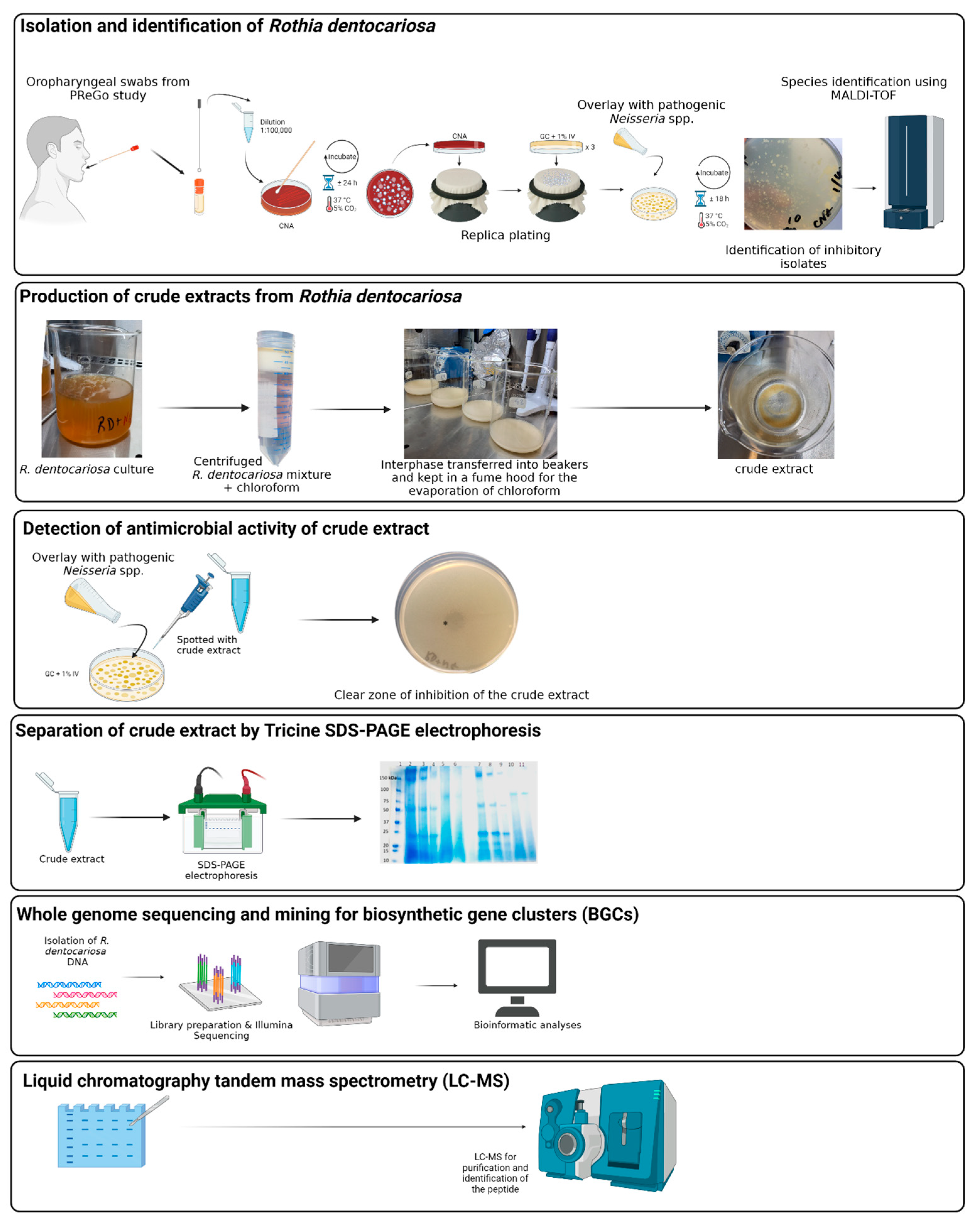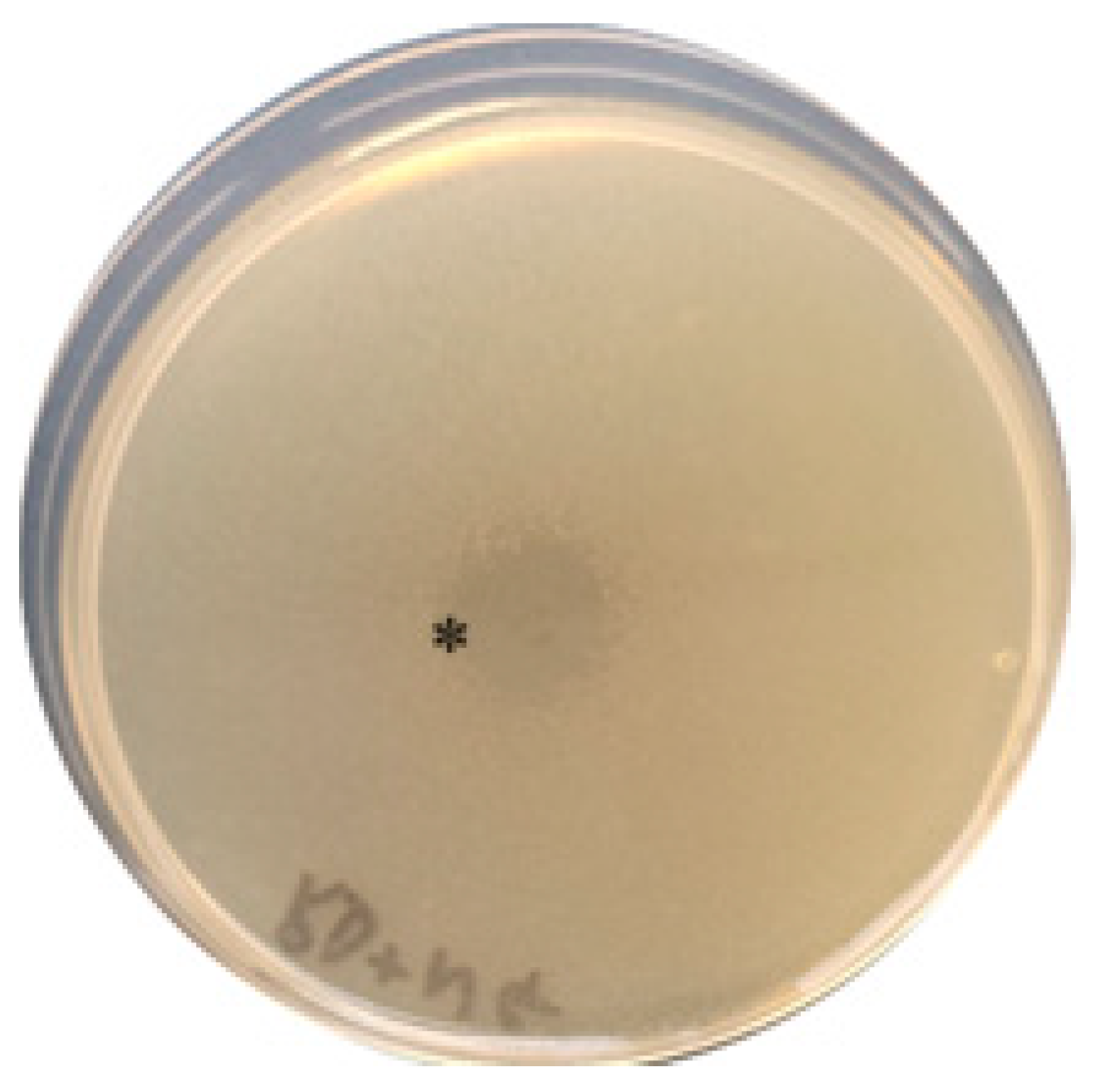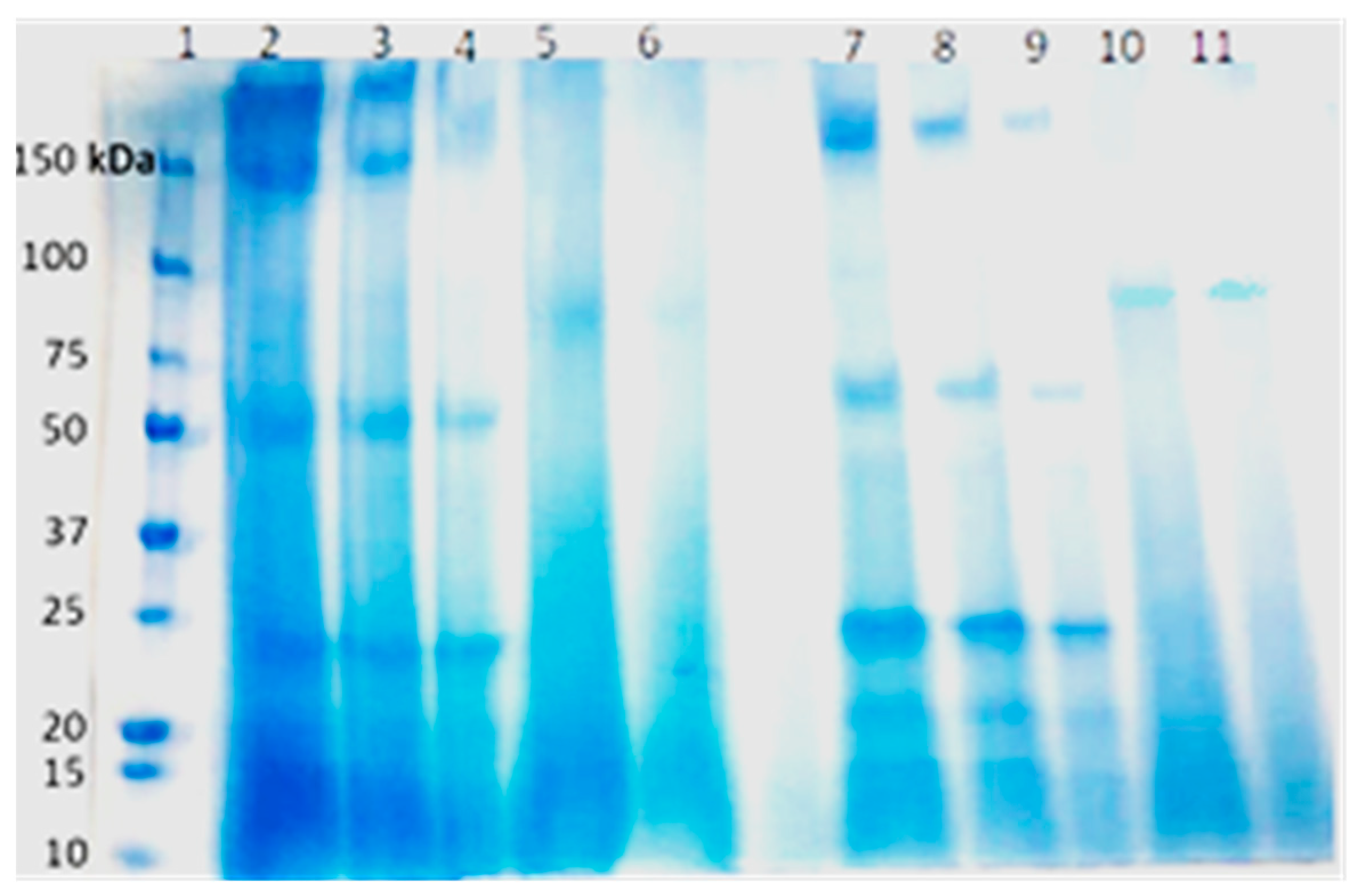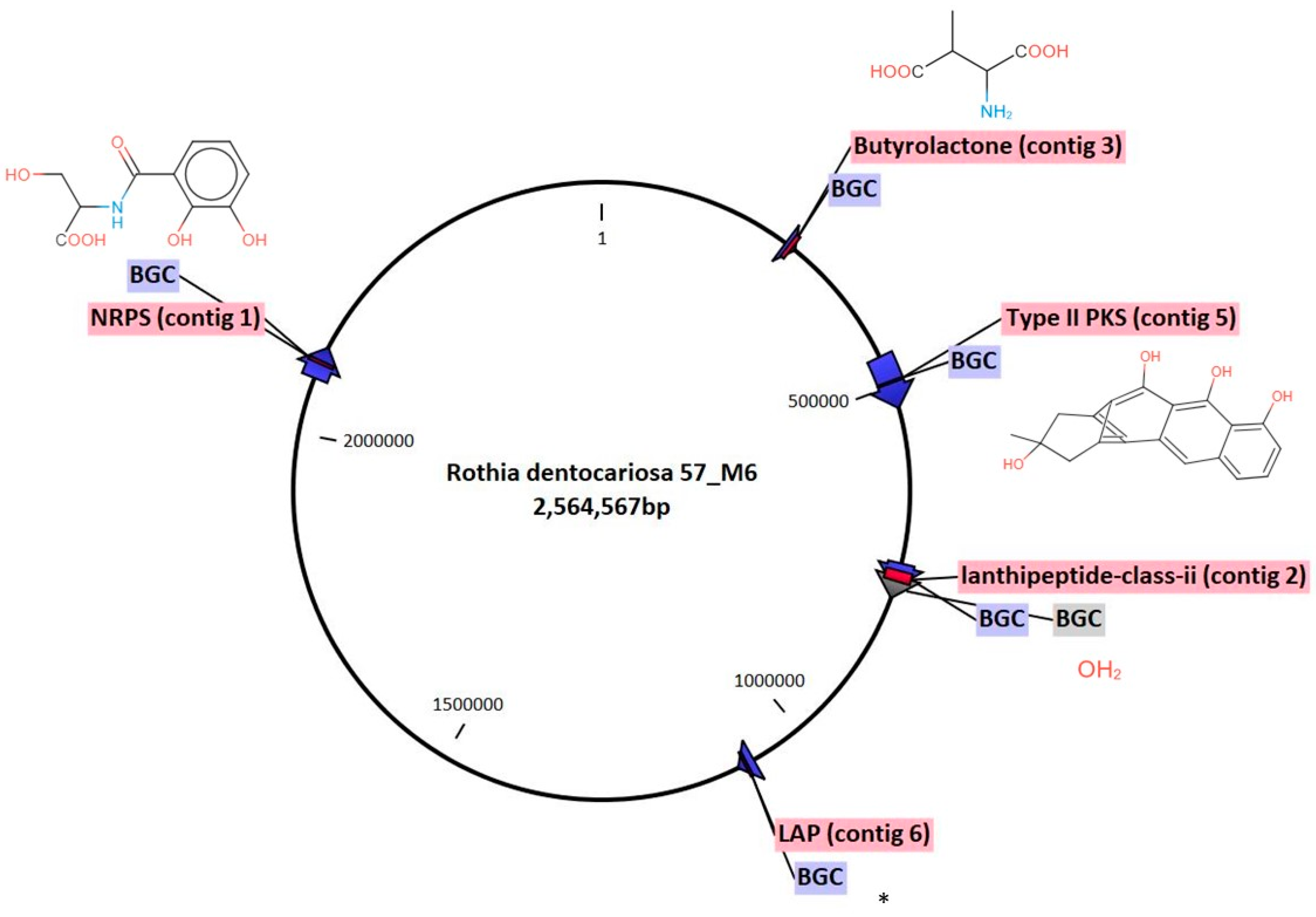Genome Mining Uncovers NRPS and PKS Clusters in Rothia dentocariosa with Inhibitory Activity against Neisseria Species
Abstract
:1. Introduction
2. Methods
2.1. Samples Used in This Study and the Isolation and Identification of Rothia dentocariosa
2.2. Production of Crude Extracts from the Rothia dentocariosa Isolate
2.3. Detection of the Antimicrobial Activity of the Crude Extract
2.4. Separation of the Crude Extract by Tricine-SDS-PAGE Electrophoresis
2.5. Whole-Genome Sequencing and Mining for Biosynthetic Gene Clusters (BGCs) in Rothia dentocariosa
2.6. Characterisation of Putative Peptides by Liquid Chromatography–Tandem Mass Spectrometry (LC-MS)
3. Results
3.1. Antibacterial Activity of the Crude Extract and Tricine-SDS-PAGE Analysis of Antibacterial Compounds
3.2. The Rothia dentocariosa Genome Possesses Multiple Secondary Metabolite Biosynthetic Gene Clusters
3.3. Identification of Peptides
4. Discussion
Supplementary Materials
Author Contributions
Funding
Institutional Review Board Statement
Informed Consent Statement
Data Availability Statement
Acknowledgments
Conflicts of Interest
References
- Human Microbiome Project Consortium. Structure, Function and Diversity of the Healthy Human Microbiome. Nature 2012, 486, 207–214. [Google Scholar] [CrossRef] [PubMed]
- Fehervari, Z. Mechanisms of Colonization Resistance. Available online: https://www.nature.com/articles/d42859-019-00018-y#author-0. (accessed on 25 May 2023).
- Vonaesch, P.; Anderson, M.; Sansonetti, P.J. Pathogens, Microbiome and the Host: Emergence of the Ecological Koch’s Postulates. FEMS Microbiol. Rev. 2018, 42, 273–292. [Google Scholar] [CrossRef] [PubMed]
- Vandenbergh, P.A. Lactic Acid Bacteria, Their Metabolic Products and Interference with Microbial Growth. FEMS Microbiol. Rev. 1993, 12, 221–237. [Google Scholar] [CrossRef]
- Corthésy, B.; Gaskins, H.R.; Mercenier, A. Cross-Talk between Probiotic Bacteria and the Host Immune System. J. Nutr. 2007, 137, 781S–790S. [Google Scholar] [CrossRef]
- Bernet-Camard, M.F.; Liévin, V.; Brassart, D.; Neeser, J.R.; Servin, A.L.; Hudault, S. The Human Lactobacillus Acidophilus Strain LA1 Secretes a Nonbacteriocin Antibacterial Substance(s) Active in Vitro and in Vivo. Appl. Environ. Microbiol. 1997, 63, 2747–2753. [Google Scholar] [CrossRef] [PubMed]
- Sulyanto, R.M.; Thompson, Z.A.; Beall, C.J.; Leys, E.J.; Griffen, A.L. The Predominant Oral Microbiota Is Acquired Early in an Organized Pattern. Sci. Rep. 2019, 9, 10550. [Google Scholar] [CrossRef]
- Baker, J.L.; Morton, J.T.; Dinis, M.; Alvarez, R.; Tran, N.C.; Knight, R.; Edlund, A. Deep Metagenomics Examines the Oral Microbiome during Dental Caries, Revealing Novel Taxa and Co-Occurrences with Host Molecules. Genome Res. 2021, 31, 64–74. [Google Scholar] [CrossRef]
- Wilbert, S.A.; Mark Welch, J.L.; Borisy, G.G. Spatial Ecology of the Human Tongue Dorsum Microbiome. Cell Rep. 2020, 30, 4003–4015.e3. [Google Scholar] [CrossRef]
- Parello, C.S.L. Microbiomics. In Translational Systems Medicine and Oral Disease; Elsevier: Amsterdam, The Netherlands, 2020; pp. 137–162. [Google Scholar]
- De Oliveira, I.M.F.; Ng, D.Y.K.; van Baarlen, P.; Stegger, M.; Andersen, P.S.; Wells, J.M. Comparative Genomics of Rothia Species Reveals Diversity in Novel Biosynthetic Gene Clusters and Ecological Adaptation to Different Eukaryotic Hosts and Host Niches. Microb. Genom. 2022, 8, 000854. [Google Scholar] [CrossRef]
- Uranga, C.C.; Arroyo, P.; Duggan, B.M.; Gerwick, W.H.; Edlund, A. Commensal Oral Rothia Mucilaginosa Produces Enterobactin, a Metal-Chelating Siderophore. mSystems 2020, 5, e00161-20. [Google Scholar] [CrossRef]
- Wang, L.; Ravichandran, V.; Yin, Y.; Yin, J.; Zhang, Y. Natural Products from Mammalian Gut Microbiota. Trends Biotechnol. 2019, 37, 492–504. [Google Scholar] [CrossRef]
- Letzel, A.-C.; Pidot, S.J.; Hertweck, C. Genome Mining for Ribosomally Synthesized and Post-Translationally Modified Peptides (RiPPs) in Anaerobic Bacteria. BMC Genom. 2014, 15, 983. [Google Scholar] [CrossRef] [PubMed]
- Ahmad, V.; Khan, M.S.; Jamal, Q.M.S.; Alzohairy, M.A.; Al Karaawi, M.A.; Siddiqui, M.U. Antimicrobial Potential of Bacteriocins: In Therapy, Agriculture and Food Preservation. Int. J. Antimicrob. Agents 2017, 49, 1–11. [Google Scholar] [CrossRef]
- Miller, B.R.; Gulick, A.M. Structural Biology of Nonribosomal Peptide Synthetases. In Nonribosomal Peptide and Polyketide Biosynthesis; Evans, B., Ed.; Humana Press: New York, NY, USA, 2016; Volume 1401, pp. 3–29. [Google Scholar]
- Kealey, J.T.; Liu, L.; Santi, D.V.; Betlach, M.C.; Barr, P.J. Production of a Polyketide Natural Product in Nonpolyketide-Producing Prokaryotic and Eukaryotic Hosts. Proc. Natl. Acad. Sci. USA 1998, 95, 505–509. [Google Scholar] [CrossRef] [PubMed]
- Ichikawa, N.; Sasagawa, M.; Yamamoto, M.; Komaki, H.; Yoshida, Y.; Yamazaki, S.; Fujita, N. DoBISCUIT: A Database of Secondary Metabolite Biosynthetic Gene Clusters. Nucleic Acids Res. 2012, 41, D408–D414. [Google Scholar] [CrossRef] [PubMed]
- Mach, B.; Reich, E.; Tatum, E.L. Separation of the Biosynthesis of the Antibiotic Polypeptide Tyrocidine from Protein Biosynthesis. Proc. Natl. Acad. Sci. USA 1963, 50, 175–181. [Google Scholar] [CrossRef]
- McIntosh, J.A.; Donia, M.S.; Schmidt, E.W. Ribosomal Peptide Natural Products: Bridging the Ribosomal and Nonribosomal Worlds. Nat. Prod. Rep. 2009, 26, 537. [Google Scholar] [CrossRef]
- Gokulan, K.; Khare, S.; Cerniglia, C. METABOLIC PATHWAYS|Production of Secondary Metabolites of Bacteria. In Encyclopedia of Food Microbiology; Elsevier: Amsterdam, The Netherlands, 2014; pp. 561–569. [Google Scholar]
- Shen, B. Polyketide Biosynthesis beyond the Type I, II and III Polyketide Synthase Paradigms. Curr. Opin. Chem. Biol. 2003, 7, 285–295. [Google Scholar] [CrossRef]
- Newman, D.J.; Cragg, G.M. Natural Products as Sources of New Drugs from 1981 to 2014. J. Nat. Prod. 2016, 79, 629–661. [Google Scholar] [CrossRef]
- Fritz, S.; Rajaonison, A.; Chabrol, O.; Raoult, D.; Rolain, J.-M.; Merhej, V. Full-Length Title: NRPPUR Database Search and in Vitro Analysis Identify an NRPS-PKS Biosynthetic Gene Cluster with a Potential Antibiotic Effect. BMC Bioinform. 2018, 19, 463. [Google Scholar] [CrossRef]
- Akomoneh, E.A.; Laumen, J.G.E.; Abdellati, S.; Van Dijck, C.; Vanbaelen, T.; Britto, X.B.; Manoharan-Basil, S.S.; Kenyon, C. The Discovery of Oropharyngeal Microbiota with Inhibitory Activity against Pathogenic Neisseria Gonorrhoeae and Neisseria Meningitidis: An In Vitro Study of Clinical Isolates. Microorganisms 2022, 10, 2497. [Google Scholar] [CrossRef] [PubMed]
- Eyre, D.W.; Sanderson, N.D.; Lord, E.; Regisford-Reimmer, N.; Chau, K.; Barker, L.; Morgan, M.; Newnham, R.; Golparian, D.; Unemo, M.; et al. Gonorrhoea Treatment Failure Caused by a Neisseria gonorrhoeae Strain with Combined Ceftriaxone and High-Level Azithromycin Resistance, England, February 2018. Eurosurveillance 2018, 23, 1800323. [Google Scholar] [CrossRef] [PubMed]
- Unemo, M.; Seifert, H.S.; Hook, E.W.; Hawkes, S.; Ndowa, F.; Dillon, J.-A.R. Gonorrhoea. Nat. Rev. Dis. Primers 2019, 5, 79. [Google Scholar] [CrossRef]
- van Dijck, C.; Tsoumanis, A.; Rotsaert, A.; Vuylsteke, B.; van den Bossche, D.; Paeleman, E.; de Baetselier, I.; Brosius, I.; Laumen, J.; Buyze, J.; et al. Antibacterial Mouthwash to Prevent Sexually Transmitted Infections in Men Who Have Sex with Men Taking HIV Pre-Exposure Prophylaxis (PReGo): A Randomised, Placebo-Controlled, Crossover Trial. Lancet Infect. Dis. 2021, 21, 657–667. [Google Scholar] [CrossRef] [PubMed]
- Lederberg, J.; Lederberg, E.M. Replica Plating and Indirect Selection of Bacterial Mutants. J. Bacteriol. 1952, 63, 399–406. [Google Scholar] [CrossRef]
- Cheng, M.; Gong, S.-G.; Lévesque, C. Rapid Isolation and Purification of Secreted Bacteriocins from Streptococcus Mutans and Other Lactic Acid Bacteria. Bio Protoc. 2020, 10, e3824. [Google Scholar] [CrossRef]
- Schägger, H.; von Jagow, G. Tricine-Sodium Dodecyl Sulfate-Polyacrylamide Gel Electrophoresis for the Separation of Proteins in the Range from 1 to 100 KDa. Anal. Biochem. 1987, 166, 368–379. [Google Scholar] [CrossRef]
- Andrews, S. FastQC: A Quality Control Tool for High Throughput Sequence Data. Available online: https://www.bioinformatics.babraham.ac.uk/projects/fastqc/ (accessed on 11 July 2023).
- Bolger, A.M.; Lohse, M.; Usadel, B. Trimmomatic: A Flexible Trimmer for Illumina Sequence Data. Bioinformatics 2014, 30, 2114–2120. [Google Scholar] [CrossRef]
- Seemann, T. Shovill. Available online: https://github.com/tseemann/shovill (accessed on 15 July 2023).
- Prjibelski, A.; Antipov, D.; Meleshko, D.; Lapidus, A.; Korobeynikov, A. Using SPAdes De Novo Assembler. Curr. Protoc. Bioinform. 2020, 70, e102. [Google Scholar] [CrossRef]
- Gurevich, A.; Saveliev, V.; Vyahhi, N.; Tesler, G. QUAST: Quality Assessment Tool for Genome Assemblies. Bioinformatics 2013, 29, 1072–1075. [Google Scholar] [CrossRef]
- Seemann, T. Prokka: Rapid Prokaryotic Genome Annotation. Bioinformatics 2014, 30, 2068–2069. [Google Scholar] [CrossRef] [PubMed]
- Blin, K.; Shaw, S.; Kloosterman, A.M.; Charlop-Powers, Z.; van Wezel, G.P.; Medema, M.H.; Weber, T. AntiSMASH 6.0: Improving Cluster Detection and Comparison Capabilities. Nucleic Acids Res. 2021, 49, W29–W35. [Google Scholar] [CrossRef] [PubMed]
- Skinnider, M.A.; Merwin, N.J.; Johnston, C.W.; Magarvey, N.A. PRISM 3: Expanded Prediction of Natural Product Chemical Structures from Microbial Genomes. Nucleic Acids Res. 2017, 45, W49–W54. [Google Scholar] [CrossRef]
- Jafari, M.; Primo, V.; Smejkal, G.B.; Moskovets, E.V.; Kuo, W.P.; Ivanov, A.R. Comparison of In-Gel Protein Separation Techniques Commonly Used for Fractionation in Mass Spectrometry-Based Proteomic Profiling. Electrophoresis 2012, 33, 2516–2526. [Google Scholar] [CrossRef] [PubMed]
- Lewis, K. Recover the Lost Art of Drug Discovery. Nature 2012, 485, 439–440. [Google Scholar] [CrossRef] [PubMed]
- Aleti, G.; Baker, J.L.; Tang, X.; Alvarez, R.; Dinis, M.; Tran, N.C.; Melnik, A.V.; Zhong, C.; Ernst, M.; Dorrestein, P.C.; et al. Identification of the Bacterial Biosynthetic Gene Clusters of the Oral Microbiome Illuminates the Unexplored Social Language of Bacteria during Health and Disease. mBio 2019, 10, e00321-19. [Google Scholar] [CrossRef]
- Zipperer, A.; Konnerth, M.C.; Laux, C.; Berscheid, A.; Janek, D.; Weidenmaier, C.; Burian, M.; Schilling, N.A.; Slavetinsky, C.; Marschal, M.; et al. Human Commensals Producing a Novel Antibiotic Impair Pathogen Colonization. Nature 2016, 535, 511–516. [Google Scholar] [CrossRef]
- Malpartida, F.; Hopwood, D.A. Molecular Cloning of the Whole Biosynthetic Pathway of a Streptomyces Antibiotic and Its Expression in a Heterologous Host. Nature 1984, 309, 462–464. [Google Scholar] [CrossRef]
- Machado, H.; Tuttle, R.N.; Jensen, P.R. Omics-Based Natural Product Discovery and the Lexicon of Genome Mining. Curr. Opin. Microbiol. 2017, 39, 136–142. [Google Scholar] [CrossRef]
- Li, Y.; Zhang, C.; Liu, C.; Ju, J.; Ma, J. Genome Sequencing of Streptomyces Atratus SCSIOZH16 and Activation Production of Nocardamine via Metabolic Engineering. Front. Microbiol. 2018, 9, 1269. [Google Scholar] [CrossRef]




| Category | Type | Contig | Region | Start (bp) | End (bp) | Size (bp) | Core Biosynthetic Genes/Product | Locus Tag | Mass Spectrometry Identification (Separated Protein on Tricine SDS-PAGE Gel) |
|---|---|---|---|---|---|---|---|---|---|
| NRPS | NRPS | 1 | 12.1 | 381,301 | 425,533 | 44,232 | Enterobactin non-ribosomal peptide synthetase EntF | INOPIIDP_01825 | Not detected |
| RiPP | lantipeptide-class-ii | 2 | 4.1 | 130,371 | 178,145 | 47,774 | Type 2 lanthipeptide synthetase LanM | INOPIIDP_00698 | Not detected |
| YcaO-like family protein | INOPIIDP_00709 | Not detected | |||||||
| Other | Butyrolactone | 3 | 2.1 | 259,764 | 275,626 | 15,862 | AfsA-related | INOPIIDP_00236 | Not detected |
| PKS | Hybrid (type II PKS) | 5 | 3.1 | 128,334 | 200,795 | 72,461 | Actinorhodin polyketide putative beta-ketoacyl synthase 2 | INOPIIDP_00466 | Not detected |
| Actinorhodin polyketide putative beta-ketoacyl synthase 1 | INOPIIDP_00467 | Detected | |||||||
| RiPP | LAP | 6 | 5.1 | 62,133 | 85,661 | 23,528 | YcaO-like family protein | INOPIIDP_00975 | Not detected |
| SagB family peptide dehydrogenase | INOPIIDP_00976 | Not detected |
Disclaimer/Publisher’s Note: The statements, opinions and data contained in all publications are solely those of the individual author(s) and contributor(s) and not of MDPI and/or the editor(s). MDPI and/or the editor(s) disclaim responsibility for any injury to people or property resulting from any ideas, methods, instructions or products referred to in the content. |
© 2023 by the authors. Licensee MDPI, Basel, Switzerland. This article is an open access article distributed under the terms and conditions of the Creative Commons Attribution (CC BY) license (https://creativecommons.org/licenses/by/4.0/).
Share and Cite
Akomoneh, E.A.; Gestels, Z.; Abdellati, S.; Vereecken, K.; Bartholomeeusen, K.; Van den Bossche, D.; Kenyon, C.; Manoharan-Basil, S.S. Genome Mining Uncovers NRPS and PKS Clusters in Rothia dentocariosa with Inhibitory Activity against Neisseria Species. Antibiotics 2023, 12, 1592. https://doi.org/10.3390/antibiotics12111592
Akomoneh EA, Gestels Z, Abdellati S, Vereecken K, Bartholomeeusen K, Van den Bossche D, Kenyon C, Manoharan-Basil SS. Genome Mining Uncovers NRPS and PKS Clusters in Rothia dentocariosa with Inhibitory Activity against Neisseria Species. Antibiotics. 2023; 12(11):1592. https://doi.org/10.3390/antibiotics12111592
Chicago/Turabian StyleAkomoneh, Elvis Achondou, Zina Gestels, Saïd Abdellati, Katleen Vereecken, Koen Bartholomeeusen, Dorien Van den Bossche, Chris Kenyon, and Sheeba Santhini Manoharan-Basil. 2023. "Genome Mining Uncovers NRPS and PKS Clusters in Rothia dentocariosa with Inhibitory Activity against Neisseria Species" Antibiotics 12, no. 11: 1592. https://doi.org/10.3390/antibiotics12111592
APA StyleAkomoneh, E. A., Gestels, Z., Abdellati, S., Vereecken, K., Bartholomeeusen, K., Van den Bossche, D., Kenyon, C., & Manoharan-Basil, S. S. (2023). Genome Mining Uncovers NRPS and PKS Clusters in Rothia dentocariosa with Inhibitory Activity against Neisseria Species. Antibiotics, 12(11), 1592. https://doi.org/10.3390/antibiotics12111592






